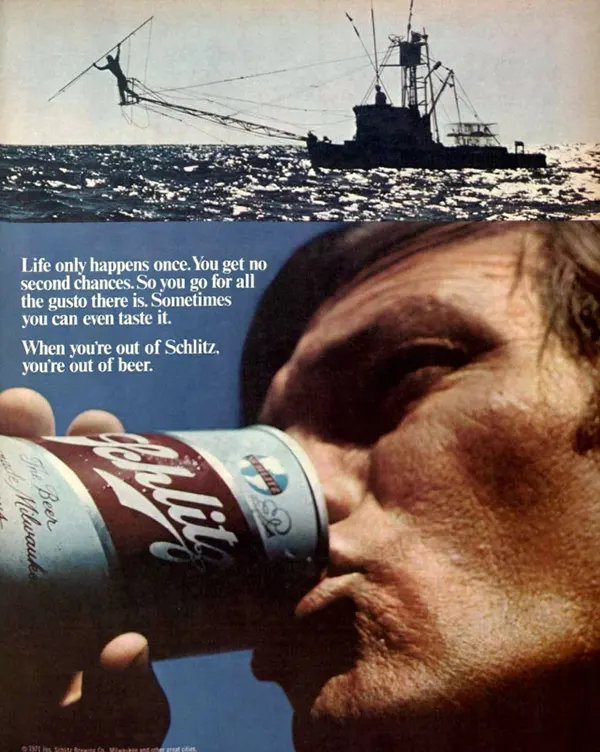One lifetime happens within a limited region of space and time. We have a rough idea of the temporal fencing that bounds it, and most of us expect to live less than another hundred years. That brings us to the single and double digits as we measure our temporal fencing. And life is always uncertain, so the remaining time may be even less than the expected one or two-digit number.
Many people, especially naive materialists, assume their life is confined to a single incarnation. They may find the ever-shrinking smallness of the temporal fencing surrounding their present incarnation claustrophobic and depressing.
When I was growing up in New York City, there were frequent ads for Schlitz beer that would show something like a self-satisfied middle-aged guy smoking a cigar, wearing a yachtsman’s cap on the deck of a boat with a couple of bikini-clad women doting on him. The voice-overs were variations of: “You only go around once in this old world, so you better grab for all the gusto you can.”
See: the closest Schlitz ad I could find

Notice this ad slogan is an entire religion in one sentence. “You only go around once…” In other words, there’s no reincarnation. But much of the world believes in reincarnation, and there are at least 2,500 impeccably documented and highly evidential cases strongly suggestive* of reincarnation.
See:The Evidence for Reincarnation is Here and Evaluating the Evidence for Reincarnation in Psychology Today.
* I say “strongly suggestive” rather than “prove” only because we could create alternative exotic, paranormal causal vectors such as a child accessing the “Akashic Record” or a collective psychic field of knowledge of a past life not their own for some bizarre reason. However, from the perspective of competitive plausibility, reincarnation easily prevails.
Many ads manufacture suffering to promote a product as the remedy. For example, ads for Certs breath mints sometimes showed a teenage boy getting rejected by a girl because he had undetected bad breath. The helpful solution was to have a mouth full of chemically-perfumed candy, which inevitably resulted in him winning the girl. Closest Certs ad I could find.
In recent years, the vile Lume company has sought to persuade consumers that they need to cover the entire surface of their body with chemical deodorants to be presentable.
Schlitz ads reject the possibility of reincarnation to increase existential anxiety. Then they offer an encompassing solution — be a greedy hedonist grabbing all the short-term pleasure you can, especially Schlitz beer. Contemporary forces manufacture suffering with the assumption of a single incarnation to promote nihilistic materialism and hedonism. “He who dies with the most toys wins.” Consumer culture’s answer to the dread ticking of the clock: “Shop till you drop.”
The fear of an ever-more-confining temporal lifefence can be used to motivate all sorts of inferior behavior. On the other hand, the sense that this particular lifetime is a limited opportunity can also motivate ethical and meaningful use of time. The shortcut to this perspective is asking yourself the question, “What will I remember well on my deathbed?”
But many of us know that fences are leaky, rickety boundaries, and souls are going over and through them, descending into fenced-in areas and ascending above them all the time.
‘Good fences make good neighbors.’
— Robert Frost, The Mending Wall
Fences are sometimes there for our benefit. They mark useful boundaries. Good fences can make good lifefields. Be fully engaged with the present dayfield by focusing on doing your best between awakening and bedtime. Awareness of the temporal fencing around your present lifefield can make you more conscious of what you are growing right now.
“The blink of an eye in itself is nothing. But the eye that blinks, that is something. A span of life is nothing. But the man who lives that span, he is something. He can fill that tiny span with meaning, so its quality is immeasurable though its quantity may be insignificant.”
― Chaim Potok, The Chosen
The size of your lifefield is not anywhere near as significant as what you are growing there.
What are you growing there?
If that seems hard to answer, then you are not being honest with yourself. What you are growing is what you spend time on. The dayfield is a microcosm of the lifefield. Each has its awakenings, its dream times, and its moments of oblivion. Temporal fencing marks a boundary between waking/birth and sleeping/dying, a boundary that’s as useful as the seasons. Each of your dayfields has an eternal significance.
Your body has about fifty trillion cells, but today, the human species consists of just eight billion dayfields. One human dayfield is a fairly substantial amount of tissue in the larger body. If the dayfield of the entire human species were a single body, your individual dayfield would comprise 3,750 cells.
Today you will grow things, and tomorrow, if it comes, you will grow more things.
Even when you are still, you grow thoughts and feelings. For example, even if you aren’t a perfect meditator, you grow awareness during the practice, and this psychic foliage shifts the collective field of human consciousness.
What sorts of thoughts and feelings are you growing in your lifefield? What sorts of relationships are you growing? Are they growing?
Plants grow, wither, grow, wither. Is there more withering or growing in your lifefield?
Your thoughts and feelings, their growth and wither cycles, often determine the growth and wither cycles of relationships and other key endeavors. A rewarding focus, therefore, is the daily harvest of thoughts and feelings you’re growing. Many of the things growing in your lifefield are primary or secondary growths of your thought/feeling harvest. How many of the thoughts and feelings growing in your lifefield are your individual harvest, and how many are sourced from the rampant collective psychosis that has long plagued the human species? Revising this card in Boulder, Colorado in 2024, I see a growing collective psychosis on both the left and the right in this country. Don’t allow the hellspawn harvest of collective psychosis to emerge from your lifefield!
What you grow is not entirely controlled by fencing. Throughout our lives, we have a succession of full dayfields before us. Whatever we grow in those dayfields has, as Whitehead put it, “the formality of actually existing.” It doesn’t matter if your existence medium is a simulated matrix, a flickering hologram, or the dreamtime. Outside the perspective of linear-time fencing, if something has ever existed, it always exists. It lives in eternity.
Fences leave huge open boundaries under the endless sky of eternity. What we grow in our lifefield has an eternal significance. Be aware of fences, but focus on what you are growing out into eternity.
Woe to the person who abandons their dayfield. Seize and grow your dayfield!
See Pathfinding/ Day-Mapping
Kill the Time Grid and Fire up your Life
Time Shifting, an article by Stephan Rechtschaffen and consider reading the book as well.
 ZapOracle.com home to the free 720-card Zap Oracle
ZapOracle.com home to the free 720-card Zap Oracle






